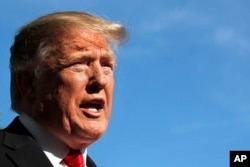U.S. President Donald Trump is seeking changes to the country's asylum system, including a proposal to charge a fee for asylum applications, as his administration tries to stop a recent rise in the number of people crossing the U.S.-Mexico border.
In a memo on Monday, Trump asked the attorney general and the head of the Department of Homeland Security to come up with four regulations within 90 days.
They include:
* Requiring a fee to apply for asylum and the work permit allowed while a case is being reviewed.
* Denying work permits to asylum-seekers who enter — or attempt to enter — the country unlawfully; that could mean restricting asylum-seekers to declare themselves at ports of entry, as the Homeland Security Advisory Council recommended earlier this month.
* Requiring the government to decide on asylum cases within six months. The process currently takes, on average, more than two years.
* Creating a separate path within immigration court for asylum cases. As is stands, asylum-seekers present themselves before an immigration judge and can avail themselves of any other immigration benefit to which they could be legally entitled; this regulation would limit the decision-making to a yes or no strictly on asylum, and eliminate the ability for asylum-seekers to seek other options at that time.
Reaction from critics
Trump's memo also calls for Homeland Security officials to reassign personnel in order to process "credible fear" claims, one of the starting points for asylum-seekers to make their case to U.S. officials.
Testifying before a House Appropriations subcommittee on Tuesday, acting DHS Secretary Kevin McAleenan, who this month took over leadership after Kirstjen Nielsen resigned, supported the idea of encouraging more asylum claims at legal border crossings.
"We would like to increase capacity to process people presenting lawfully, even if they don't have documents, at ports of entry," he told lawmakers.
U.S. Rep. Lucille Roybal-Allard, who heads the subcommittee that questioned McAleenan, said Tuesday that "simply making it harder to claim asylum in the United States is not the answer."
Human Rights First warned that Trump's proposed regulations risk "rushing cases through the system."
"Yet again, the Trump Administration is attempting to trample on the law when it doesn't line up with its hard-line immigration policies," a statement from the human rights organization read.
Delayed implementation
The Trump administration has implemented multiple policies and strategies at the border, some of which are facing legal challenges, at a time when an increasing number of families entering without authorization.
Unlike some of Trump's immigration-related executive orders, the latest proposed regulatory changes will not be immediate — the process for establishing new regulations can take years, and will be open to public comment.
U.S. border agents have apprehended more than 100,000 people at the southwestern border this fiscal year, about double the number at this point in 2018, with a particular rise in the number of parents traveling with young children.
Many of those traveling through Mexico to seek entry into the United States are coming from El Salvador, Honduras and Guatemala, and their reasons for doing so vary.
Motivators can include reasons people want to leave their home country (violence, persecution, economic insecurity, natural disaster) or want to come to the United States (to join family, seek safety or asylum, earn more money), and policies in the U.S. and Latin America.












